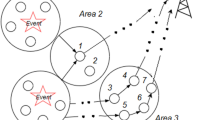Abstract
In this paper, the influence of the features of the propagation channel in the performance of energy-efficient routing algorithms for wireless sensor networks is studied. Although there are a lot of works regarding energy-efficient routing protocols, almost no reference to realistic propagation channel models and influence is made in the literature. Considering that the propagation channel may affect the efficiency of the different energy-efficient routing algorithms, different propagation scenarios are proposed in this work, from the most simplistic free-space propagation model to more complex ones. The latter includes the effects of multipath propagation, shadowing, fading, etc. In addition, spatial diversity transmission/reception models are considered to mitigate the effects of hard propagation fading. Some results are provided comparing the performance of several energy-efficient routing algorithms in different scenarios.
Similar content being viewed by others
References
Akyildiz I. F., Su W., Sankarasubramaniam Y., Cayirci E. (2002) Wireless sensor networks: A survey. Computer Networks 38(4): 393–422
Anastasi G., Conti M., Di Francesco M., Passarella A. (2009) Energy conservation in wireless sensor networks: A survey. Ad Hoc Networks 7(3): 537–568
Akkaya K., Younis M. (2005) A survey on routing protocols for wireless sensor networks. Ad Hoc Networks 3(3): 325–349
Akyildiz I. F., Kasimoglu I. H. (2004) Wireless sensor and actor networks: Research challenges. Ad Hoc sNetworks 2: 351–367
Akyildiz I. F., Wang X., Wang W. (2005) Wireless mesh networks: A survey. Computer Networks 47(4): 445–487
Mauve M., Widmer A., Hartenstein H. (2001) A survey on position-based routing in mobile ad hoc networks. IEEE Network 15(6): 30–39
Peng B., Kemp A. H. (2011) Energy-efficient geographic routing in the presence of localization errors. Computer Networks, 55(3, 21): 856–872
Mao G., Fidan B., Anderson B. D. O. (2007) Wireless sensor network localization techniques. Computer Networks 51(10): 2529–2553
Seada, K., Zuniga, M., Helmy, A., & Krishnamachari, B. (2004). Energy-efficient forwarding strategies for geographic routing in lossy wireless sensor networks. In Proceedings of the 2nd international conference on Embedded networked sensor systems (SenSys ’04), New York, NY, USA: ACM (pp. 108–121).
Zorzi M., Casari P., Baldo N., Harris A. (2008) Energy-efficient routing schemes for underwater acoustic networks. IEEE Journal on Selected Areas in Communications 26(9): 1754–1766
Matrouk K., Landfeldt B. (2009) RETT-gen: A globally efficient routing protocol for wireless sensor networks by equalising sensor energy and avoiding energy holes. Ad Hoc Networks 7(3): 514–536
Jin Y., Jo J., Wang L., Kim Y., Yang X. (2008) ECCRA: An energy-efficient coverage and connectivity preserving routing algorithm under border effects in wireless sensor networks. Computer Communications 31(10): 2398–2407
Lattanzi E., Regini E., Acquaviva A., Bogliolo A. (2007) Energetic sustainability of routing algorithms for energy-harvesting wireless sensor networks. Computer Communications 30(14–15): 2976–2986
Abdulla, A., Nishiyama, H., & Kato, N. (2011). Extending the lifetime of wireless sensor networks: A hybrid routing algorithm. Computer Communications. Available online October 15, 2011.
Zorzi M., Rao R. R. (2003) Geographic random forwarding (GeRaF) for ad hoc and sensor networks: Multihop performance. IEEE Transactions on Mobile Computing 2(4): 337–348
Abdallah A. E., Fevens T., Opatrny J., Stojmenovic I. (2010) Power-aware semi-beaconless 3D georouting algorithms using adjustable transmission ranges for wireless ad hoc and sensor networks. Ad Hoc Networks 8(1): 15–29
Papadopoulos, A., Navarra, A., McCann, J. A., & Pinotti, C. M. (2011). VIBE: An energy efficient routing protocol for dense and mobile sensor networks. Journal of Network and Computer Applications. Available online May 24, 2011.
Alotaibi, E., & Mukherjee, B. (2011) A survey on routing algorithms for wireless ad-hoc and mesh networks. Computer Networks. Available online November 15, 2011.
Vazifehdan J., Prasad R. V., Onur E., Niemegeers I. (2011) Energy-aware routing algorithms for wireless ad hoc networks with heterogeneous power supplies. Computer Networks 55(15): 3256–3274
Zhang, H., & Shen, H. (2007). EEGR: Energy-efficient geographic routing in wireless sensor networks. In International Conference on Parallel Processing, ICPP 2007.
Stojmenovic I., Nayak A., Kuruvila J., Ovalle-Martinez F., Villanueva-Pena E. (2005) Physical layer impact on the design and performance of routing and broadcasting protocols in ad hoc and sensor networks. Computer Communications 28(10): 1138–1151
Rappaport T. (2002) Wireless communications: Principles and practice. Prentice-Hall, Englewood Cliffs, NJ
Molisch A. F. (2005) Wireless communications. Wiley–IEEE press, London
Goldsmith A. (2004) Wireless communications. Cambridge University Press, Cambridge
Prabhu G. S., Shankar P. M. (2002) Simulation of flat fading using MATLAB for classroom instruction. IEEE Transactions on Education 45(1): 19–25
Pérez Fontán, F., & Mariño Espiñeira, P. (2008). Modeling the wireless propagation channel: A simulation approach with MATLAB. Wiley series on wireless communications and mobile computing.
Gomez-Calero C., Cuellar L., de Haro L., Martinez R. (2011) A 2 × 2 MIMO DVB-T2 system: Design, new channel estimation scheme and measurements with polarization diversity. IEEE Transactions on Broadcasting 57(2): 195–203
Gesbert D., Shafi M., Shiu D. S., Smith P., Naguib A. (2003) From theory to practice: An overview of MIMO space-time coded wireless systems. IEEE Journal on Selected Areas in Communications 21(3): 281–302
Gomez-Calero, C., Garcia-Garcia, L., de Haro-Ariet, L. (2006). New test-bed for evaluation of antenna and system performance for MIMO systems. In First European Conference on Antennas and Propagation, EuCAP 2006.
Author information
Authors and Affiliations
Corresponding author
Rights and permissions
About this article
Cite this article
Padilla, P., Camacho, J., Maciá-Fernández, G. et al. On the Influence of the Propagation Channel in the Performance of Energy-Efficient Geographic Routing Algorithms for Wireless Sensor Networks (WSN). Wireless Pers Commun 70, 15–38 (2013). https://doi.org/10.1007/s11277-012-0676-5
Published:
Issue Date:
DOI: https://doi.org/10.1007/s11277-012-0676-5




